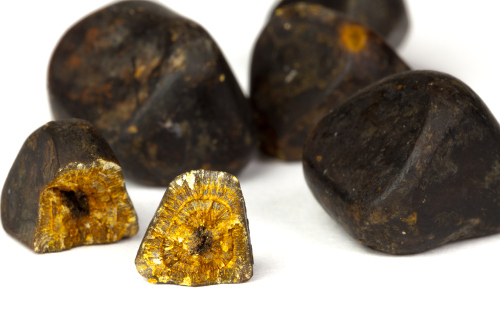
Credit: iStock.com/piotr_malczyk
I love my work. Not only do I write and give you the straight goods on getting healthy, but I also get to learn some of the most remarkable and strange facts about health every day.
For example, I was recently enlightened about one of the common symptoms that many of us suffer from—pain in the abdomen.
The most common causes of abdominal pain are colic caused by gas or irritable bowel syndrome. But in some cases, the pain could be caused by something more serious, like a gallstone.
What Are Gallstones?
Gallstones (choleliths) are small crystalline clumps that form in the gallbladder or bile ducts, which empty bile into the small intestine.
There are two types of gallstones—cholesterol stones and pigment stones.
Most gallstones are cholesterol stones that mainly consist of undiluted cholesterol but may contain other constituents. They are usually yellow in color.
Pigment gallstones, on the other hand, are dark brown or black and form as a result of too much bilirubin in sterile bile.
Causes and Symptoms of Gallstones
While gallstones can occur in anybody at any age, it’s good to remember the five F’s—fat, forty, female, fertile, and fair. That’s because overweight (fat), premenopausal (fertile and forty), and Caucasian women (fair and female) are most prone to gallstone formation.
The pain caused by a gallstone (biliary colic) can last from 30 minutes to a couple of hours and can be severe enough to induce vomiting. The pain is sharp and radiates from around the liver region to the right shoulder.
If the gallstones obstruct the flow of bile into the intestine, it can lead to inflammation of the gallbladder, bile ducts, and even the pancreas. A gallstone can also lead to gallbladder cancer.
But, there are some natural ways to prevent gallstones.
How to Prevent Gallstones
Most doctors will advise you to drink plenty of water as well as fruit and vegetable juices like beetroot, carrot, tomato, lemon, and celery. You should also opt for a fiber-rich diet with healthy fats consisting of foods like whole grains, nuts, brown rice, coconut oil, avocado, and fatty fish.
Related Article: Gallbladder Diet: Foods to Eat and Avoid
But, there is one prevention trick that your doctor may not tell you about.
Alcohol. Yes, that’s right!
According to the National Institutes of Health, moderate drinking (one glass per day for women and two for men) of red wine or beer helps reduce bad cholesterol. And, studies also show that increased cholesterol levels can lead to gallstone formation.
So, if you do the math, drinking alcohol could reduce the risk of gallstones.
Having said that, if you don’t drink alcohol, don’t start now. Eating fiber-rich foods and healthy fats is the way to go. But, if you do like your wine or beer, moderation is the key to including it as part of your anti-gallstone regime.
Related Articles
A Unique Way to Prevent Gallstones
Gallstones and Pain in the Upper-Right Abdomen
Sources:
Arranz, S., et al., “Wine, Beer, Alcohol and Polyphenols on Cardiovascular Disease and Cancer,” Nutrients, July 2012; 4(7): 759-781. DOI: 10.3390/nu4070759.
“Cholelithiasis (Gallstones),” University of Michigan Medical School; http://www.med.umich.edu/lrc/coursepages/m1/anatomy2010/html/clinicalcases/cholelithiasis/cholelithiasis.html.
Sambrook, J., “Gallstones Diet Sheet,” Patient, February 15, 2017; https://patient.info/health/gallstones-diet-sheet.
Paassilta, M., et al., “Effect of moderate alcohol consumption on Lp(a) lipoprotein concentrations,” The BMJ, May 30, 1998; 316(7145): 1675; https://www.ncbi.nlm.nih.gov/pmc/articles/PMC1113249/.
Atamanalp, S.S., et al., “The effects of serum cholesterol, LDL, and HDL levels on gallstone cholesterol concentration,” Pakistan Journal of Medical Sciences, January-March 2013; 29(1): 1887-190. DOI: 10.12669/pjms.291.2798.
